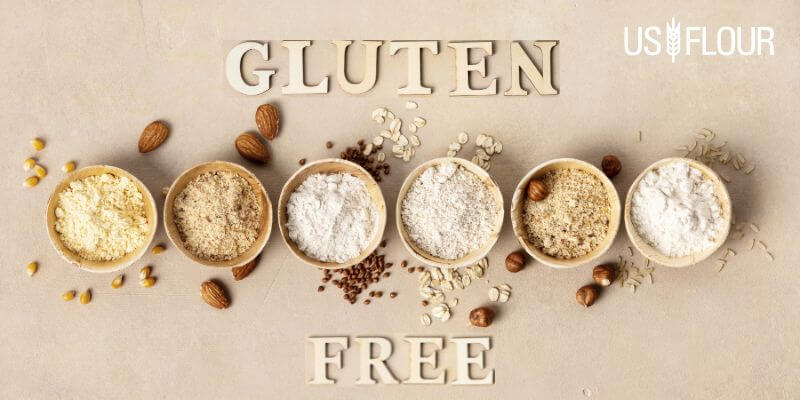5 Alternative Flours to Use in Gluten-Free Baking

You should be reassured if you must bake and cook with gluten-free flour. Substituting gluten-free flour in most recipes is relatively easy. It can be easily used instead of traditional flours in many recipes. There are different flour types, with some gluten-free and others not. Here is all to know about gluten-free flour for baking.
What Is Gluten-Free Flour?

In gluten-free flour, gluten has been removed from the recipe to make it easier to digest for people with allergies and intolerances. Oat flour, coconut flour, almond meal, and rice flour are the most common gluten-free flour used in baking. Each of these types offers a unique texture and taste to baked goods.
Regarding recipes like cookies, cakes, and bread, gluten-free flour cannot replace traditional flour. Nevertheless, they offer tasty alternatives, as they can produce delicious dishes with a nutty flavor and a slightly heavier texture.
5 Alternatives Flours to Use in Gluten-Free Baking

Different types of gluten-free flour can be used for baking. Understanding the ratios required to substitute traditional flour with gluten-free type when developing new recipes is essential for using the various gluten-free flour in baking.
Here are five gluten-free flour alternatives for baking:
1. Almond flour
Of all the gluten-free flour, almond flour is among the most commonly known ones. Blanched almonds that are ground are used to make this type of flour. A nutty flavor characterizes almond flour and contains about 90 almonds per cup. It is frequently used in baked items and is a grain-free substitute for breadcrumbs.
Also, almond flour is typically used instead of wheat or regular flour in a 1:1 proportion. However, you should use one more egg when baking with this flour. You will have a thicker batter and a denser end product in this case.
Minerals like potassium, calcium, magnesium, iron, manganese, and copper can be found in almond flour. Furthermore, it contains monounsaturated fat and vitamin E in reasonable amounts. All nuts, including almonds, are naturally gluten-free, but it is still a good idea to read the label on the flour to ensure it has not been made in a facility that also processes gluten.
2. Sorghum flour
Ancient cereal grains are used to make sorghum flour. In addition to being gluten-free, it is considered the world’s fifth most important cereal grain. It has a sweet, mild flavor and a light texture and color.
Given that sorghum flour is dense or heavy, it is frequently used with other gluten-free flour or in recipes that only call for a small amount of flour. Due to its high fiber and protein content, sorghum grain may help decrease the absorption of sugar.
Additionally, there is an abundant presence of mineral iron in sorghum flour. It contains antioxidants as well. While being processed, sorghum flour could become gluten-contaminated. Therefore, look for the label that says it is gluten-free.
3. Buckwheat flour
Buckwheat is gluten-free and not a wheat grain. It is a member of the family of pseudocereals, a class of grains that are consumed similarly to cereal but are not members of the grass family. When used to make yeast and quick bread, buckwheat flour imparts a rich, earthy flavor.
Buckwheat flour tends to be crumbly because it needs gluten. Combining it with other gluten-free flour, like brown rice, will help make a quality product. It is rich in fiber, manganese, zinc, magnesium, folate, and iron and contains B vitamins.
Buckwheat flour is also rich in antioxidants with properties like polyphenol rutin. When being processed, transported, or grown in rotation with wheat, buckwheat may come into contact with gluten-related foods. To be safe, also look for the type verified to be gluten-free.
4. Teff flour
Teff is the world’s smallest grain, which is 1/100 the size of a wheat kernel. It is available in various colors, including red, white, and dark brown. Darker colors taste more earthy, whereas lighter colors have a milder flavor. For centuries, teff flour has been used to create injera, an Ethiopian fermented bread that resembles sourdough.
Snacks, bread, cereals, and pancakes are other foods that teff flour is now used to make. It can be used in place of 25 to 50% of all-purpose or wheat flour. Teff flour has much protein, which encourages feeling full and may even help you feel less hungry.
Additionally, the fiber content of teff flour can aid weight loss, decrease appetite, and manage blood sugar levels. It is the only ancient grain that contains vitamin C and has the highest calcium content of any grain. To guarantee that your teff flour is entirely gluten-free, as with any grain, check the location of its processing.
5. Amaranth flour
As with buckwheat, amaranth is also considered to be a pseudocereal. The Inca, Maya, and Aztec cultures initially regarded this collection of more than 60 grains as a staple diet. Amaranth tends to absorb the flavors of other ingredients and has an earthy, nutty flavor.
Although amaranth flour should be mixed with other flour when baking, it could substitute 25% of wheat flour. Making bread, pie crusts, and tortillas are the three things that are best made using this flour. It is a good source of protein, fiber, and trace minerals selenium, manganese, magnesium, phosphorus, and iron.
The nutrients in amaranth flour help with DNA synthesis, bone health, and brain function. You must also check the label before buying amaranth flour if you are gluten intolerant.
Conclusion
Many alternative flours are available for those who want to avoid gluten in their baking. From almond flour to amaranth flour, each flour has its unique flavor and texture that can add depth to baked goods. Experiment with different flours to find the best ones for your needs and taste preferences.
 Power to The Bakers.
Power to The Bakers.